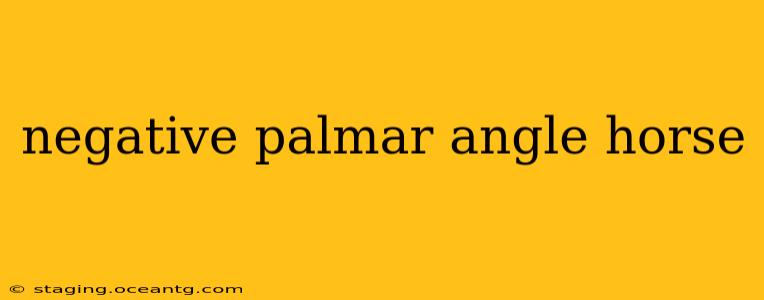A negative palmar angle in horses refers to a conformation where the pastern slopes more steeply backward than the ideal 45-degree angle. This deviation from the optimal angle can significantly impact a horse's soundness, athletic performance, and overall well-being. Understanding the causes, consequences, and management of a negative palmar angle is crucial for horse owners and professionals alike.
What is a Negative Palmar Angle?
The palmar angle is the angle formed by the intersection of the ground and the horse's pastern. An ideal palmar angle is generally considered to be around 45 degrees. A negative palmar angle signifies that the pastern slopes backward, exceeding this 45-degree mark, sometimes drastically. This steeper slope places increased stress and strain on the joints and soft tissues of the lower leg.
Causes of a Negative Palmar Angle
Several factors can contribute to the development of a negative palmar angle in horses:
- Genetics: Inheritance plays a significant role. Certain breeds or bloodlines may have a predisposition toward this conformation.
- Conformation: Other related conformational issues like upright pasterns or short, steep heels can exacerbate the negative palmar angle.
- Farrier Practices: Improper trimming or shoeing can contribute to the development or worsening of a negative palmar angle. Incorrect hoof balance can force the pastern into an unnatural position.
- Injury or Disease: Previous injuries to the fetlock, pastern, or hoof can alter the normal biomechanics of the leg, leading to a negative palmar angle. Certain conditions affecting bone or joint health may also contribute.
What are the Consequences of a Negative Palmar Angle?
A negative palmar angle predisposes horses to several issues:
- Increased Stress on Joints: The steeper angle puts extra pressure on the fetlock, pastern, and coffin joints, leading to increased wear and tear. This can accelerate the onset of degenerative joint disease (DJD).
- Higher Risk of Injury: The abnormal stress on the joints and supporting structures increases the risk of injury, including fractures, ligament sprains, and tendonitis.
- Impact on Performance: Horses with a negative palmar angle often display reduced athletic performance, especially in disciplines requiring high-speed maneuvers or repetitive impact. Their movement may be stiff, short-strided, and less efficient.
- Pain and Lameness: Over time, the chronic stress can lead to pain and lameness, significantly impacting the horse's comfort and ability to work.
How is a Negative Palmar Angle Diagnosed?
Veterinarians use a combination of techniques to diagnose a negative palmar angle:
- Visual Assessment: Observing the horse’s stance and conformation from different angles.
- Palpation: Feeling the structures of the leg to assess joint mobility and any signs of inflammation or pain.
- Radiography (X-rays): To evaluate the joint integrity and assess for any bone spurs, fractures, or degenerative changes.
Treatment and Management of a Negative Palmar Angle
Management focuses on mitigating the negative effects and preventing further damage:
- Farrier Management: Careful trimming and shoeing are critical. The farrier must strive to create a balanced hoof that encourages a more natural pastern angle. Specialized shoeing techniques may be necessary.
- Therapeutic Interventions: Veterinary treatments may involve anti-inflammatory medications to reduce pain and inflammation. In more severe cases, therapies such as shockwave therapy, injections, or surgery might be considered.
- Exercise Modification: Adjusting the horse's exercise regimen to reduce the stress on the affected leg. This might involve limiting high-impact work or using therapeutic exercise to build strength and improve overall function.
Can a Negative Palmar Angle Be Prevented?
While not always preventable, careful selection of breeding stock, proper hoof care from an early age, and attention to overall conformation can significantly reduce the risk. Regular veterinary check-ups are crucial to detect any early signs of problems.
Frequently Asked Questions (FAQs)
What is the ideal palmar angle for a horse?
The ideal palmar angle is generally considered to be around 45 degrees. However, the optimal angle can vary slightly depending on the breed and the individual horse's conformation.
How does a negative palmar angle affect a horse's gait?
A negative palmar angle can lead to a shorter, stiffer stride, reduced shock absorption, and increased stress on the lower limbs. The horse's gait might appear choppy or less fluid.
Can a negative palmar angle be corrected?
While a fully formed negative palmar angle is difficult to fully correct, careful farrier management and other therapeutic interventions can often significantly improve the situation, reducing pain and improving function.
What are the long-term implications of a negative palmar angle?
Long-term implications can include degenerative joint disease, increased risk of injuries, chronic pain, and reduced athletic performance. Early intervention is key to managing the condition and prolonging the horse's career.
This information is for general knowledge and should not be considered veterinary advice. Always consult with a qualified equine veterinarian for diagnosis and treatment of any lameness or conformational issues in your horse.
